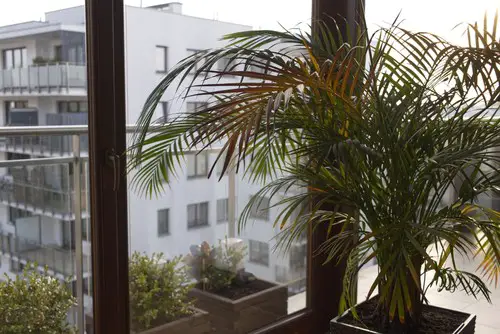Areca palms are popular indoor plants known for their lush green foliage and air-purifying qualities. However, one common issue that plant owners face is their Areca palm leaves turning brown. This problem can be frustrating, especially when you have invested time and effort into caring for your plant.
Understanding the reasons behind the browning of areca palm leaves is crucial in addressing the issue. There are several potential causes, including overwatering, underwatering, nutrient deficiency, pests, and diseases. Identifying the problem correctly is essential to help you take corrective measures and prevent further damage to the plant.
Key Takeaways
- Understanding the causes of browning of areca palm leaves is crucial in addressing the issue.
- Common causes of browning include overwatering, underwatering, nutrient deficiency, pests, and diseases.
- Identifying the problem correctly is essential to take corrective measures and prevent further damage to the plant.
Also see:
Understanding Areca Palms

Areca palms, also known as Dypsis lutescens, are a popular indoor plant that can add a tropical touch to any home or office. They are native to Madagascar and can grow up to 20 feet tall in their natural habitat. However, when grown indoors, they typically reach a height of 6 to 10 feet.
Areca palms have long, feathery fronds that can grow up to 8 feet long. These fronds are a bright green color and add a lush, tropical feel to any space. The plant is easy to care for and can thrive in a variety of lighting conditions. However, if the leaves start to turn brown, it’s a sign that something is wrong.
There are several reasons why areca palm leaves may turn brown. Overwatering, underwatering, nutrient deficiencies, pests, and diseases can all cause the leaves to turn brown. Additionally, sudden temperature changes or exposure to direct sunlight can also cause the leaves to brown.
To keep areca palms healthy and prevent brown leaves, it’s important to provide them with the right growing conditions. They prefer bright, indirect light and should be watered when the top 2 inches of soil are dry. Fertilizing every two months can also help keep the plant healthy.
Identifying the Problem
Areca palms are popular indoor plants that can add a touch of tropical beauty to any space. However, if you notice that your areca palm leaves are turning brown, it may be a sign of an underlying problem that needs to be addressed.
Brown tips or fronds are the most common symptom of an unhealthy areca palm. This can be caused by a variety of factors, including overwatering, underwatering, insufficient light, overfertilizing, low humidity, chlorinated water, pests, or unnecessary repotting.
Yellow leaves or spots may also indicate a problem with your areca palm. This can be caused by a lack of nutrients, overexposure to direct sunlight, or exposure to cold drafts. Brown spots or leaf spots may be a sign of a fungal or bacterial infection, which can spread quickly and cause the plant to wilt and die.
Stunted growth and a general unhealthy appearance may also be a sign of a problem with your areca palm. This can be caused by a lack of nutrients, insufficient light, or root rot.
To identify the problem with your areca palm, it’s important to observe the plant closely and look for any of these symptoms. Checking the soil moisture, light exposure, and humidity levels can also help you determine the cause of the problem.
Once you have identified the problem, you can take steps to address it and help your areca palm recover. This may involve adjusting the watering schedule, providing more or less light, adding fertilizer, or treating the plant for pests or diseases. With proper care and attention, your areca palm can thrive and continue to add beauty to your indoor space.
Areca Palm Leaves Turning Brown – 6 Common Problems
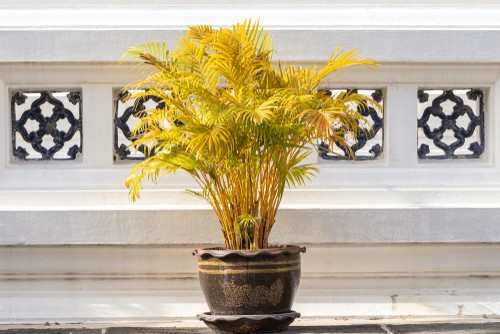
Areca palms are popular indoor plants known for their lush green fronds and air-purifying capabilities. However, if you notice brown tips or spots on the leaves, it’s a sign that something is amiss. Here are some common causes of browning in areca palm leaves:
1. Watering Issues
Overwatering or underwatering are the most common causes of browning in areca palm leaves. If the soil is waterlogged or too dry, the roots can’t absorb nutrients properly, leading to brown tips or leaves. It’s important to water the plant when the top 1-2 inches of soil is dry and ensure proper drainage by having drainage holes in the pot.
2. Soil Conditions
Areca palms prefer moist soil that is well-draining and rich in nutrients. If the soil is too compacted or lacks nutrients, it can lead to browning in the leaves. Using a well-draining potting mix with perlite and fertilizing with a balanced water-soluble fertilizer every two months can help prevent this.
3. Sunlight and Temperature
Areca palms thrive in bright, indirect sunlight and temperatures between 16°C to 24°C. Direct sunlight or sudden temperature changes can cause brown spots on the leaves, so it’s important to place the plant in a location with indirect sunlight and avoid placing it near drafts or heating/cooling vents.
4. Humidity Levels
Areca palms prefer high humidity levels, and low humidity can cause browning in the leaves. Misting the leaves or placing a tray of water near the plant can help increase humidity levels.
5. Fertilizer
Overfertilizing or using fertilizer with high levels of salts can cause fertilizer burn and lead to browning in the leaves. Using a balanced fertilizer and following the instructions on the label can help prevent this.
6. Compacted Roots
Compacted roots can prevent the plant from absorbing nutrients properly, leading to browning in the leaves. Repotting the plant every 2-3 years with fresh potting mix can help prevent this.
By addressing these common causes of browning in areca palm leaves, you can help your plant thrive and stay healthy.
Pests and Diseases
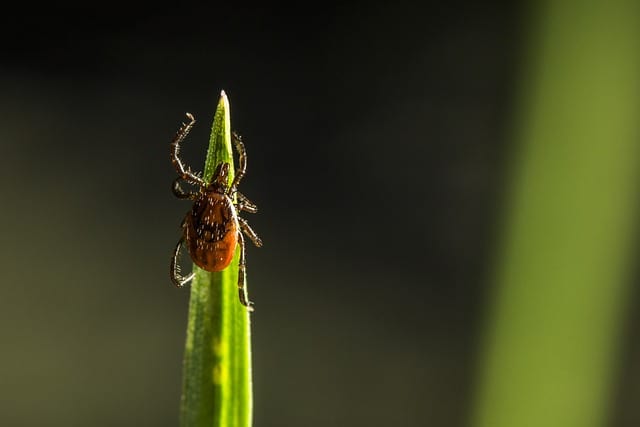
Areca palms are susceptible to a range of pests and diseases that can cause their leaves to turn brown. Identifying and treating these issues early can help protect your plant and keep it healthy. Here are some common pests and diseases that can affect areca palms:
Pests
Spider Mites: These tiny pests can cause damage to the leaves of your areca palm, leading to brown spots and discoloration. They thrive in dry conditions and can quickly multiply, causing a severe infestation. Treatment involves removing any infected leaves and applying a pesticide specifically designed for spider mites.
Scale: Scale insects can cause brown patches on the leaves of your areca palm. These pests feed on sap, which can cause the leaves to wilt and eventually die. Treatment involves removing any infected leaves and applying a pesticide specifically designed for scale.
Mealybugs: These pests can cause yellowing and browning of leaves, as well as stunted growth. Mealybugs can be difficult to treat, but using a systemic insecticide can be effective in killing them.
Diseases
Root Rot: Overwatering can lead to root rot, which can cause the leaves of your areca palm to turn brown. To prevent root rot, make sure your plant is not sitting in water and that the soil is well-draining.
Leaf-Spot Disease: This fungal disease can cause brown spots on the leaves of your areca palm. Treatment involves removing any infected leaves and applying a fungicide.
Gliocladium Blight: This disease can cause the leaves of your areca palm to turn brown and eventually kill the plant. Treatment involves removing any infected leaves and applying a fungicide.
In summary, areca palms can be vulnerable to pests and diseases that can cause brown leaves. Identifying and treating these issues early can help protect your plant and keep it healthy.
Corrective Measures
If an areca palm’s leaves are turning brown, there are several corrective measures that can be taken to restore its health.
1. Watering
One of the most common reasons for brown leaves on an areca palm is improper watering. Overwatering or underwatering can cause stress to the plant, resulting in brown tips and leaves. The soil should be kept moist but not waterlogged, and the plant should be watered once a week. If the soil is dry to the touch, it’s time to water the plant.
2. Leaching
Leaching is the process of flushing excess salts and minerals from the soil to prevent buildup, which can cause brown leaves. To leach an areca palm, water the plant thoroughly until water runs out of the bottom of the pot. Repeat this process several times to ensure that all excess salts and minerals have been removed.
3. Fertilizing
Fertilizing an areca palm once a month during the growing season can help prevent brown leaves. Use a balanced fertilizer with equal parts nitrogen, phosphorus, and potassium. Overfertilizing can cause brown tips and leaves, so it’s important to follow the instructions on the fertilizer package carefully.
4. Repotting
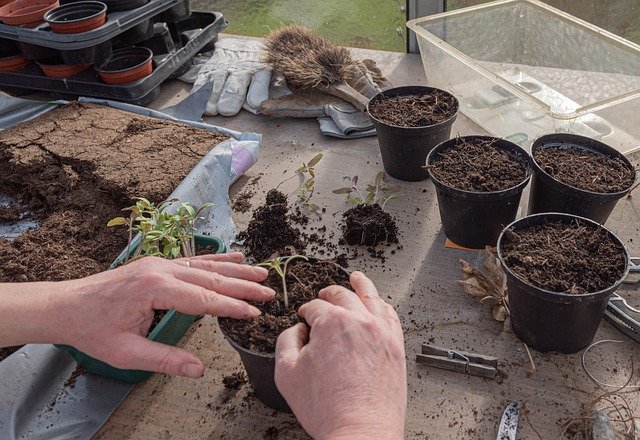
If the areca palm is root-bound, it may need to be repotted. Repotting should be done in the spring or summer when the plant is actively growing. Choose a pot that is one size larger than the current pot and use a well-draining soil mix.
5. Pruning
Pruning can help remove brown leaves and promote new growth. Use sharp, clean pruning shears to remove any dead or brown leaves, making sure to cut as close to the stem as possible. Do not remove more than 20% of the plant’s leaves at once.
6. Absorbing Water
To ensure that the areca palm is absorbing water properly, make sure that the soil is not compacted. Compact soil can prevent water from reaching the roots, causing brown leaves. Gently loosen the soil around the plant to ensure that water can penetrate the soil.
7. Not Getting Enough Water
If the areca palm is not getting enough water, it can also cause brown leaves. Make sure to water the plant once a week and adjust watering frequency as needed based on the plant’s environment.
By following these corrective measures, the areca palm can be restored to its healthy, vibrant state.
Preventive Care for Areca Palms
Areca palms are relatively easy to care for, but they do require some attention to prevent leaves from turning brown. Here are some tips for preventive care:
1. Watering

Overwatering or underwatering can cause brown tips and leaves on your Areca Palm. Areca Palms like fairly moist, but not waterlogged soil most of the time, and once the soil dries out, they will start to show signs of stress.
Make sure to water your plant regularly when the top two inches of soil are dry. Check the soil before watering the plants each session to make sure the soil is not already moist.
2. Light
Areca palms thrive in bright, indirect light. Direct sunlight can scorch the leaves, while too little light can cause the leaves to turn yellow and brown. Place your plant in a location with indirect sunlight to prevent brown leaves.
3. Temperature and Humidity
Areca palms prefer temperatures between 16°C to 24°C. Sudden, swift temperature changes might harm the plant and can lead to brown spots on the leaves. These plants also grow taller than a lot of other indoor plants. You can expect them to grow to a height of 6 to 10 feet.
Areca palms also require a moderate level of humidity. Dry air can cause the tips of the leaves to turn brown. Use a humidifier or place a tray of water near the plant to increase the humidity level.
4. Fertilizer
Areca palms benefit from regular fertilization. Fertilize every two months during the growing season with a balanced, water-soluble fertilizer. Do not over-fertilize, as this can cause the tips of the leaves to turn brown.
By following these preventive care tips, you can keep your Areca Palm healthy and prevent leaves from turning brown.
Frequently Asked Questions
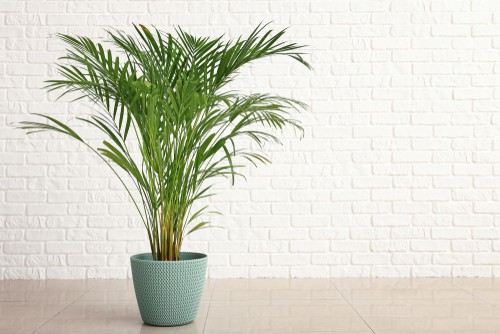
Why is my areca palm leaves turning brown?
Areca palm leaves can turn brown due to various reasons, such as overwatering, underwatering, insufficient light, low humidity, over fertilizing, pests, or unnecessary repotting. Identifying the cause is essential to help fix the problem.
How do you fix brown leaves on areca palm?
Fixing brown leaves on an areca palm depends on the cause. For example, if the cause is overwatering, reduce the frequency of watering and ensure proper drainage. If the cause is underwatering, increase the frequency of watering and ensure the soil is moist but not waterlogged.
If the cause is low humidity, increase the humidity level by placing a humidifier nearby or misting the leaves. If the cause is pests, treat the plant with an appropriate insecticide.
What does an overwatered areca palm look like?
An overwatered areca palm may have yellow or brown leaves that are soft and mushy to the touch. The soil may also have a foul smell and appear waterlogged. If left untreated, overwatering can lead to root rot and ultimately kill the plant.
How often do you water areca palm?
The frequency of watering an areca palm depends on various factors such as the size of the plant, the size of the pot, the humidity level, and the temperature. As a general rule, water the plant when the top inch of soil feels dry to the touch. Avoid overwatering, as it can lead to root rot.
Areca palm leaves turning yellow and brown
Areca palm leaves turning yellow and brown can be a sign of overwatering, underwatering, low humidity, or pest infestation. It is important to identify the cause and take appropriate measures to fix the problem.
How to save dying areca palm
To save a dying areca palm, identify the cause of the problem and take appropriate measures. For example, if the cause is overwatering, reduce the frequency of watering and ensure proper drainage.
If the cause is underwatering, increase the frequency of watering and ensure the soil is moist but not waterlogged. Additionally, ensure the plant receives sufficient light, proper humidity, and appropriate fertilization. If the plant is severely damaged, pruning may be necessary.

Hey, I’m Lisa and I’ve been an avid gardener for over 30 years. I love writing, talking and living in the garden! Feel free to connect with me on my socials below

